Executive Community of Practice: Organizations, Why be Agile’ish? Just B.E.E. Agile!
Executive Community of Practice is a series of articles designed to inspire knowledge sharing and built-in solutions.
How are you doing your part for your organization to mature in agility?
As an organization, what reason would you settle for being Agile’ish when everyone can do their part to Believe, Embrace, and Excel in the same thing: Agile?
When the most senior person (CEO, Founder) has decided that Agile is the right fit and solution for their organization, everyone should feel obligated to do their part to ensure a successful and quick conversion.
Agile states for organizations are: Not Agile, Agile’ish, and Agile. As an individual, you are either Agile or you’re not. A distinction is not that simple for an enterprise that is branded as Agile. However, it is fair that: If no one is Agile, then the organization is not Agile. If a few to some people are Agile, then the organization is Agile’ish. If all or most people in an organization are Agile, then the organization is Agile; it’s securely woven into the fabric of their culture.
From my personal observations and Agile learning, here are a few characteristics of Agile’ish and Agile environments:
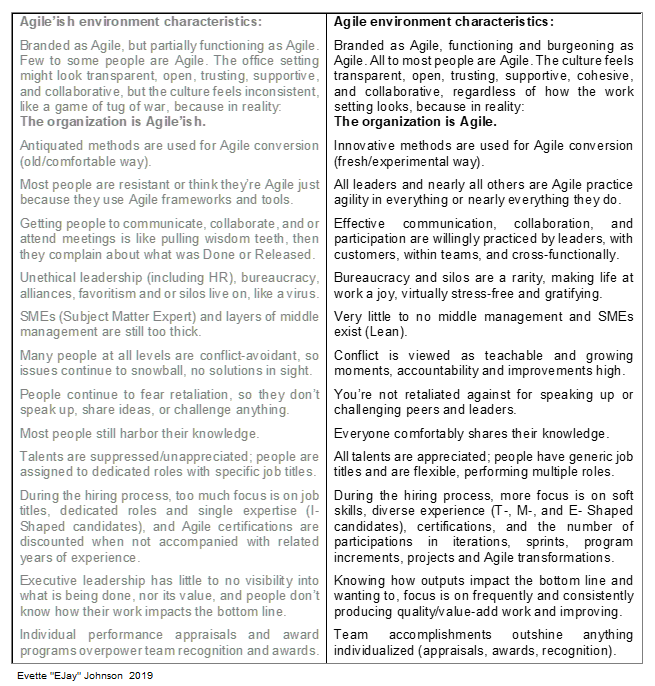
Oh, if you don’t already know, Agile is not something you do. Agile is a philosophy. Agile is who you are. Definitions vary for Agile, ideally based on the four Agile Values and twelve Principles found in the Agile Manifesto. Because you are Agile you naturally think and function in ways to empirically, collaboratively, frequently, and consistently produce quality outputs, always with customers in mind [my delineation].
Whether you use standard Agile frameworks in whole or in part or develop your own ways of producing quality outputs incrementally, it’s your mindset that makes you Agile. Having an Agile mindset and an open mind, you free-think. You know the possibilities in applying agility are limitless—it can be used for more than software development. Agile is industry blind and functional area blind, serving needs from software and hardware development to processes and services in virtually any type of enterprise.
So being Agile you want to and do work efficiently as possible in everything you do to frequently yield quality outputs, regardless of your job title, department, or the industry you work in, and especially if that means adopting fresh ways to get work done. You might even find yourself being Agile when completing personal projects at home or while volunteering.
Because Agile environments embody teamwork, collaboration, openness, integrity, transparency, trust, respect, knowledge sharing, fearlessness, and experimentation to result in quality outcomes and continuous improvement: You feel it and you see it.
As for Agile frameworks, they are user-friendly. Sprouted from the Agile Manifesto: Agile frameworks are simply a collection of best practices—all of us have been doing for years—that have been deftly enhanced with global terminology. Whether we use Scrum, Kanban, Extreme Programming/XP, SAFe, etc. or produce outputs incrementally in iterations, all of us use the same terminology.
Imagine the ideal scenario of every single person in an enterprise becoming Agile upon its announcement. In a live broadcast after pleasantries, the CEO announces something like: “We are shifting to Agile. It basically means changing the way we think. This means going forward all of us should think value-add, transparency, teamwork, and collaboration to help us work more efficiently to frequently produce quality throughput. We’re going this direction because the business needs call for change; we’re a little too slow. And we, your executive leadership team, believe agility is the solution. We need to be faster to market. We need your help to make it happen. It’s okay to feel a little uncomfortable, we are too. Let’s all learn together and improve together as we transform to Agile.” With that announcement, all or most minds become Agile and within a few months all teams are practicing agility.
Now you might be thinking, if only Agile conversions were that easy. In reality you’re dealing with people, so that makes culture shifts arduous. We know converting most or all minds to Agile takes patience and time… People embracing Agile. Tirelessly influencing people to believe in agility. It also takes patience and time to see how well agility works.
Amid the patience and time, another reality is that some factors prevent people from becoming Agile, thus prolonging Agile conversion completeness. Those factors range from individual blockers to organization culture flaws, specific types and magnitude vary enterprise to enterprise:
- Uncertainty of where to begin (Believe first then do, do then believe, or believe while doing?); which Agile frameworks to use and how; or what the future holds
- Intimidation of anything new or that which appears to be different or complex
- Skepticism whether agility is a solution for generating quality outputs fast
- Complacency, settled in the current state; don’t like change or feeling uncomfortable
- Insecurities or competitive, such as being jealous, envious; or intimidated by others (teammates, business partners, hiring candidates) who are skilled in agility and she or he doesn’t
- Resistance, thinking the current way of working and harboring knowledge means job security; or because if agility works, then producing quality throughput more frequently would become the norm instead of the current acceptance of antiquated ways of working and mediocre results
- Fear of exposure, such as issues that have been masked with manual processes or temporary fixes; non value-add work; or lack of skills
- Fear of job loss during restructuring when you easily adapt and are willing to learn new things (via certifications, peer-to-peer; or self-learning with books, the Agile Manifesto, The Scrum Guide, SAFe Website, YouTube, etc.)
- Fear of job loss during layoffs because of the boss not liking you, not endorsing you, or not presenting your true talents on individual performance appraisals
- Distractions, such as dealing with personal problems, team conflict, uncooperative cross-functional business partners, silos, or unethical management and HR personnel
- Poor leadership that doesn’t seem to care about people or being Agile, so why should anyone else
- Bureaucracy, egos, and nonsense aka bullsh*t, from instigating chaos to favoritism to retaliation to workplace bullying, all which are poison thus cripple an organization’s culture and Agile conversion efforts
Aside from why negative issues exist in the workplace at all, you might be thinking: The fewer impediments that exist or the quicker they are addressed, the less time organizations spend in the Agile’ish space of their conversion. You’re right!
How can people fully receive the concept of agility when they are faced with individual blockers, team deficiencies, and organization culture defects?
At some point, distinctions and decisions have to be made. What’s tolerable and what’s unacceptable. What moves people and the organization toward agility and what does not. Being a part of the problem or solution. Hindering your Agile conversion or supporting it.
Being a part of the solution and fully supporting the Agile conversion means people taking ownership of doing their part to result in individuals, teams, and their organization quickly adopting agility.
Compartmentalizing those parts might look something like this:
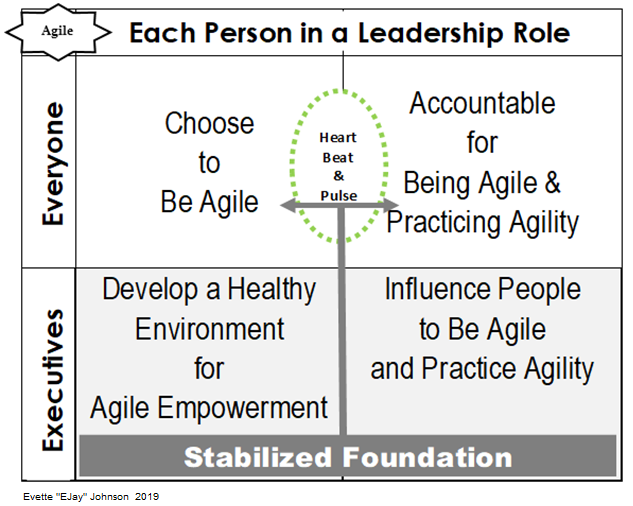
- Leaders, starting at the top with executives, develop a healthy environment for Agile empowerment. Aside from having a tough job of running their enterprise, executive/ senior leaders have the power to prevent and remove the largest impediments fear, bureaucracy, nonsense, unfairness, and to help set teams up for success. Leadership ensures that tools are available for teams to perform quality work. Stabilizing the foundation with all leaders categorically supporting the Agile conversion, exuding behavior that is congruous with their organization’s core values and code of ethics, and all leaders being on the same page enable people to become Agile and confidently practice agility.
- Leadership influence. In addition to embracing Agile, practicing agility, and serving as role models, starting at the top with executive/ senior leaders it is the duty for any person in a leadership role to inspire and influence people to be Agile and practice agility as a part of their foundation stabilization. After all, the ability to influence others is a common leadership quality and requirement for people in leadership positions.
- Choose to be Agile. Individuals must choose to do what it takes to understand what Agile is, adopt an Agile mindset, and practice agility as a team. A great attitude, team player mentality, adaptability, respect, trust, open-mindedness, transparency, collaboration, and participation in meetings (stand ups/ ceremonies, sprint reviews, retrospectives, program increment (PI) planning, etc.) are also paramount in choosing to be Agile—none of these should be like pulling wisdom teeth. This goes double for people in leadership roles because they have a larger responsibility of maintaining a sound foundation.
- Accountability. Once the most senior person in the organization makes it known that Agile is the solution, each person is responsible for adapting and adjusting accordingly. People are responsible for becoming Agile and practicing agility as a team. Individuals and teams are responsible for acknowledging and addressing blockers and deficiencies which prevent them from being Agile. Leaders, specifically executive/ senior leadership, are also accountable for swiftly addressing culture defects (negative factors which impede agility prosperity). People who are Agile (Agilists) should be examples and role models as encouragement for others. Everyone should ensure that work life embodying transparency, integrity, trust, collaboration, and team camaraderie is felt and seen. Accountability goes double for people in leadership roles who hold themselves, one another, and others accountable.
Think of a stable foundation stabilized by senior leaders as the vein of oxygen for the heartbeat and pulse that fluidly enables people to become Agile and practice agility. Having a quality attitude, everyone should want to do their part to experience a complete Agile transformation.
If an Agile conversion never reaches its fullness, a “Done” status, how will leaders and teams determine how well agility works for their projects and organization as a whole?
Your organization will reach its Agile conversion fullness when you and your team reach your fullness of BEE’ing Agile. Do an inspection (deep dive), if necessary to make it happen. You could do an evaluation, analysis, or perhaps partner with your mentor or Agile coach.
Another way to perform an inspection aka pop the hood and get your hands dirty is a deep-dive technique I refer to as S.T.A.C.K.’ing that is done through integrity and openness: Stop! Think. Assess. Care. Know.
[Here context for STACK’ing is delivered mostly in question format from a professional certified coach’s perspective for becoming Agile.]
Stop! Stop…take time out. Confirm more about Agile and yourself.
EVERYONE: What will you do so your beliefs are closely matched to the Agile Manifesto? What have you learned about various Agile frameworks (Scrum, Extreme Programming/XP, SAFe, etc.), Lean, and Kanban? How does being Agile impact your use of the Waterfall methodology? How are you addressing what prevents you from being transparent and open-minded to the possibilities of agility? What are you doing to increase your comfort level with producing outputs incrementally?
EXECUTIVES: What are the takeaways from your benchmarks with a few Agile organizations and interactions with internal teams that might already be Agile? How does Agile and Lean fit into your business needs? How can you begin to honestly inspire others to adopt an Agile mindset and utilize Agile frameworks if you haven’t? How does your moral compass and ability to empathize guide your decisions that impact people?
Think. Think about what you expect when practicing agility.
EVERYONE: Knowing the purpose and responsibilities of your team, how do you think your team and functional area will benefit from agility?
EXECUTIVES: What reasons are you converting your organization to Agile? Knowing the purpose and responsibilities of areas in your enterprise, how do you think each functional area and your organization overall will benefit from agility? Thinking holistically (from people to security and privacy to technology and automation to the bottom line) and considering business predictions, how does Agile fit into future plans for your organization?
Assess. Assess exactly what is currently going on to strategize for improvement and determine expectations.
EVERYONE: What are the reasons quality work isn’t being produced frequently? What are the root causes for the biggest issues in your area? People are paid to work, so which outputs are value-add—positively impacting the bottom line—and which ones are nonvalue-add (waste that can be eliminated)?
EXECUTIVES: What are the biggest issues in your organization? Given that: untapped talent might not be exposed, managers tend to promote and reward people they like, performance appraisals are subjective (sometimes riveted with biases—contrast, halo, horn, leniency, recency), and layoffs might be unavoidable, how do you truly identify top talent? It’s one thing to trust mid-level leaders, including human resources, to remain ethical; it’s another thing to know all of them are categorically ethical. Needing quality leaders with character and integrity who are a part of the solution, how do your town hall meetings, employer surveys, and feedback (or complaints) help you to identify which leaders, including HR, are ethical and which ones are not?
Care. Care enough to design and build in solutions. That could include self-adjusting and collaborating to broaden perspectives, be prudent in decisioning, and to ensure that everyone is on the same page.
EVERYONE: Using the Agile Manifesto, how do you define Agile? Which Agile framework(s) are best suited for your projects? How do your solutions address security, privacy, and dependencies? What do you expect out of your Community of Practice groups?
EXECUTIVES: Which Agile framework(s) will you utilize to inject agility into your organization’s culture? Knowing that multiple teams could be working on the same project and to quickly view projects and metrics, what reason wouldn’t you select one dynamic Agile tool (Axosoft, Easy Redmine, Hygger, Jira, etc.) for your organization to use? What are solutions for the biggest challenges your organization faces? Given people with a diverse expertise portfolio (T-, E-, M- Shaped) are versatile and flexible in usefulness for agility, how could their talent benefit your business needs? During your Agile transformation, how can you preserve what works and also resolve some long-standing issues?
Know. Know the approach to quickly become Agile so your team and organization can experience the results of agility.
EVERYONE: How will you contribute to a full Agile conversion? How will you contribute to continuous improvement for: Yourself? Your team?
EXECUTIVES: What do you think is the best approach to convert your organization to Agile? How will you contribute to continuous improvement for your organization?
Below are a few examples of possible S.T.A.C.K.’ing results . . .
EVERYONE:
- To be a part of the solutions you adopt Agile, practice agility, and have fun as a team experimenting with different Agile frameworks or being innovative and creative to produce quality outputs incrementally.
- To become more marketable and enhance your resume you establish yourself as an Agilist; because you are Agile, you practice agility, and you have the ability to inspire or coach an Agile mindset.
- To accommodate special projects an Agile/Waterfall hybrid methodology is developed.
EXECUTIVES:
- To increase a team mentality and cohesiveness: performance appraisals are discontinued; increases are standardized; team recognition and awards come from leadership; and individual recognition comes from peers.
- To ensure unbiased fairness, human resources is revamped with a deep focus on career development and relationship strengthening.
- To help develop a healthy work environment executive leaders and agile coaches partner together to tackle issues using Kanban—major issues and conflicts are handled by execs and small to medium issues and conflicts are handled by agile coaches.
- To see how agility works, two areas or teams are piloted: one with big issues and one with small or no issues.
- To provoke excitement for converting to Agile and minimize fear of job loss: The CEO is transparent. Talent is primarily sought internally during restructuring. And a rehire program is implemented.
- To ensure alignment of organizational goals and to restore integrity middle management in each functional area is collapsed into two flexible roles who work as a team (strategy, budgets, planning)—something like Jr. VP-Program, responsible for overseeing all projects; and Jr. VP-People, responsible for development, removing impediments, coaching, training, hiring
- Considering business trends and predictions and to ensure that teams are able to efficiently practice agility, funding is wisely invested in the proper tools, a stable infrastructure, automation, and technology.
- As a part of the strategy to inspire people to be Agile, functional areas are pollinated with internal and external Agilists.
- For people to have dedicated time to get quality work Done, knowing that working in the field offers direct visibility into end-user experience, and understanding that people are at their best at different times of the day, a work from home and flex-time policy is implemented.
- To help people focus on value-add and for everyone to see how their work impacts the bottom line all work is linked to a project.
- Amid restructuring and fairly adjusting pay ranges to help prevent layoffs, generic job titles and views for them are developed incrementally. Examples—Transparency View: Everyone has visibility into base salary ranges and potential career paths. Restricted View: For executives and those who need-to-know have a snap shot of payroll, financial impacts, and are able to quickly identify talent.
Increment 1: Job titles crafted
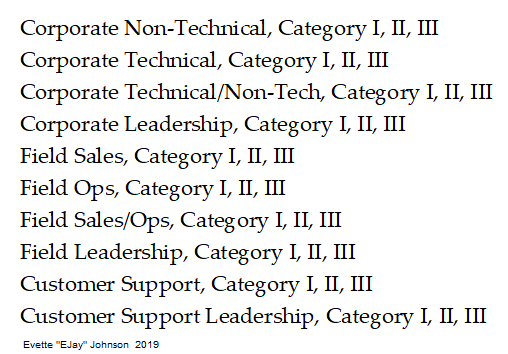
Increment 2: Transparency view for everyone (example)
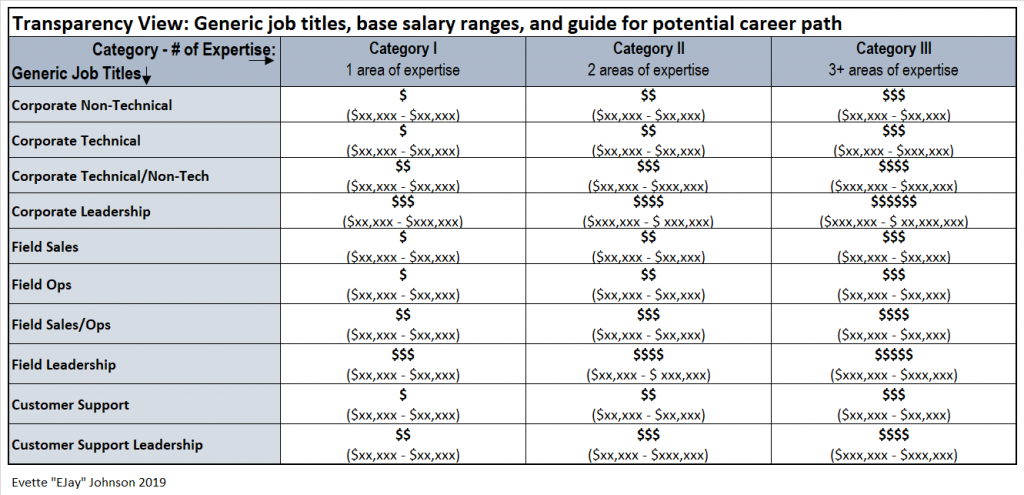
Increment 3: Restricted view for executives and need-to-know only (example)
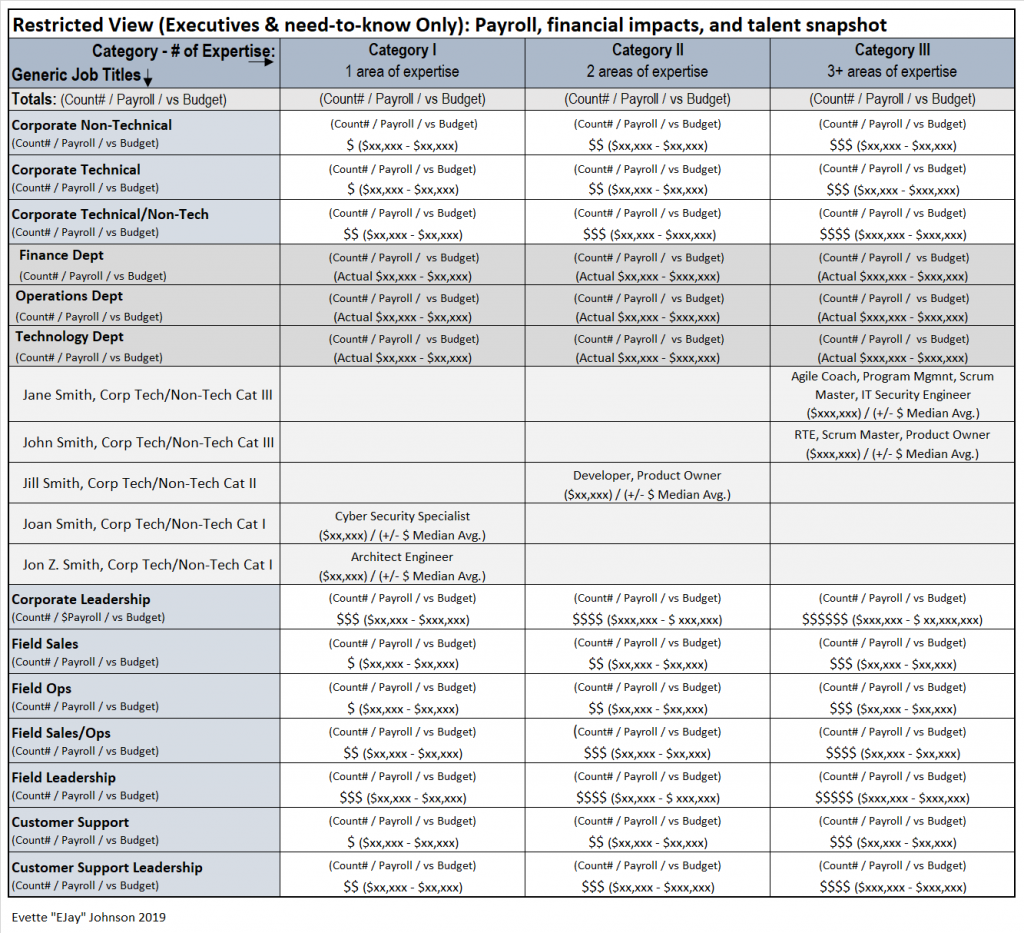
- To rally excitement around an Agile conversion and have visibility into its progress an internal dashboard is developed incrementally for all to see and share comments.
Increment 1: Basic dashboard with gauges (example)
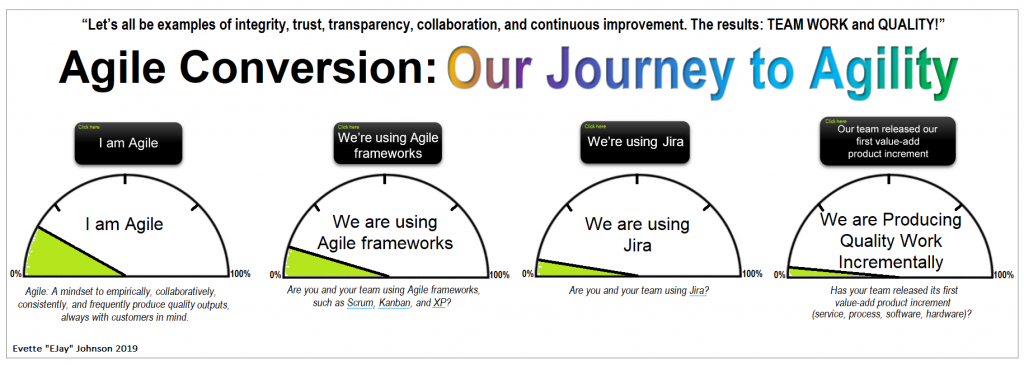
Increment 2: Dashboard with pics of executive leadership and feedback box (example)
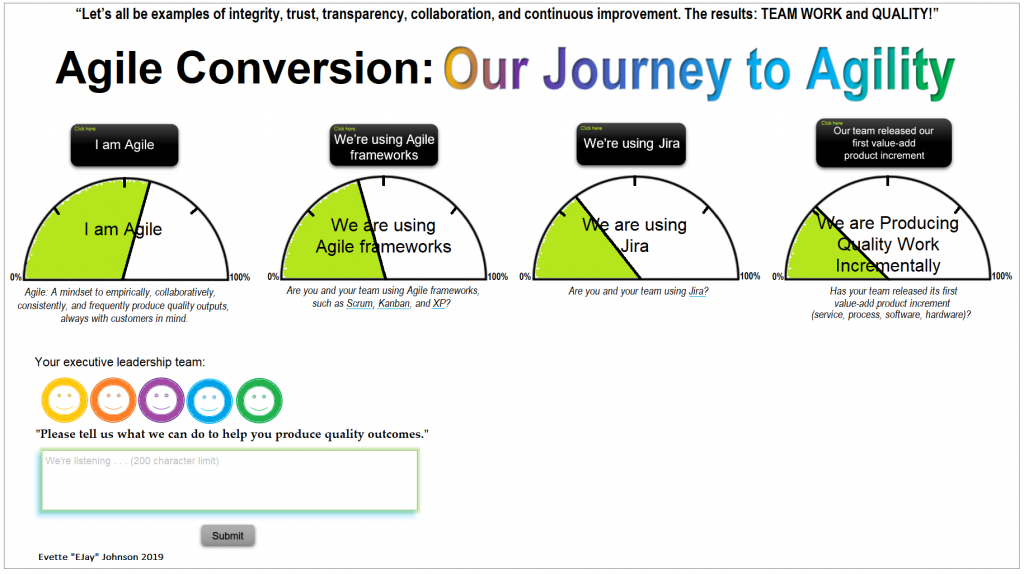
Increment 3: Dashboard with executive video message and public comment section (example)
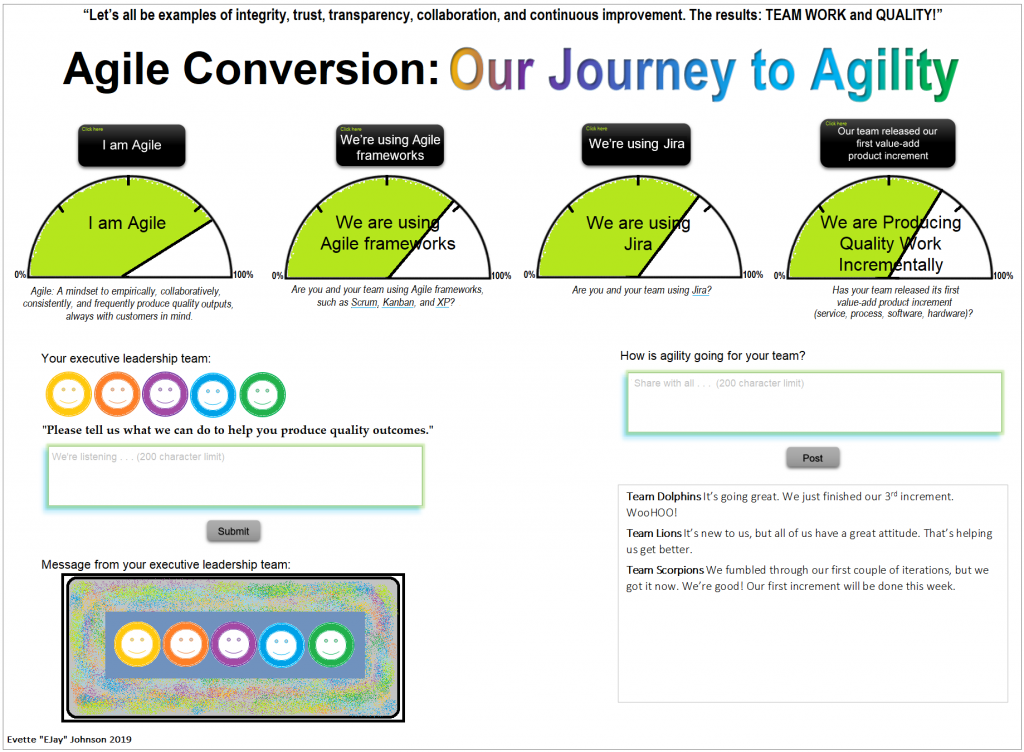
What are the results of your S.T.A.C.K., or inspection (deep dive) regardless of the way you do it?
For organizations to reap expected quality results of agility, beginning at the top with executive/ senior leadership, everyone must have a quality attitude and do their part to: Believe in Agile. Embrace Agile mindset. Excel in Agility. (BEE Agile!) Committing to BEE’ing Agile, you, your team, and organization will continuously improve in agility.
What will you do to fulfill your part to become Agile and practice agility?








